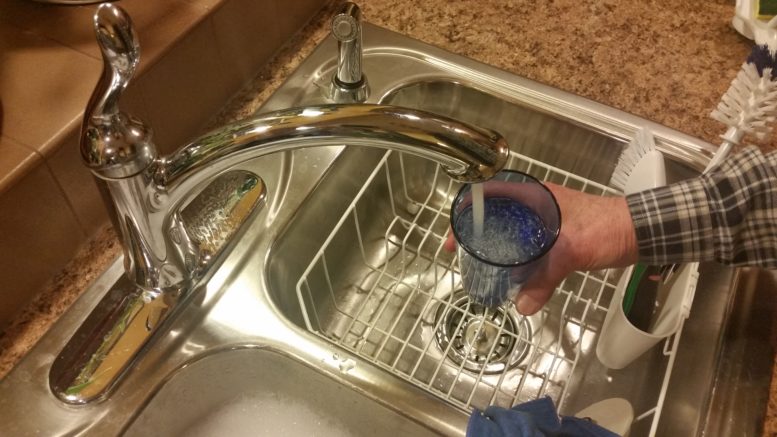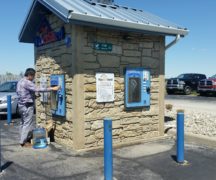By JAN LARSON McLAUGHLIN
BG Independent News
Concerns about water quality, quantity and costs have resulted in a possible regional water system with Toledo in the center. But if that Plan A falls apart, then the northern Wood County area is eyeing a possible Plan B involving Bowling Green water.
The Northwestern Water and Sewer District held a public meeting in Perrysburg Thursday evening to talk about possible options for approximately 6,500 of its water customers in northern Wood County.
To serve its northern customers, the district currently purchases water from Toledo, then distributes it to Rossford, Northwood, Walbridge, Perrysburg Township, Troy Township and Lake Township.
The status quo has been disrupted in the past few years by several concerns about Toledo water quality and cost. Toledo has been ordered to make many water system improvements, with the costs being passed on to customers who already pay large surcharges. Complaints from communities served by the district have shown growing dissatisfaction over the rates and the water quality since the Toledo system went through the algal bloom crisis of 2014.
The district’s contract with Toledo water expires in 2024 – which in water agreement years is not much time.
Meanwhile, talks with Toledo are still not quite complete, and negotiations with Bowling Green haven’t even begun.
Rex Huffman, attorney with the district, explained at Thursday’s meeting that several political entities served by Toledo water share the same concerns. So after months of negotiations, the Toledo Area Water Authority was created. Signing a memorandum of understanding for TAWA were officials from the Northwestern Water and Sewer District, Toledo, Lucas County, Maumee, Perrysburg, Sylvania, Whitehouse, Fulton County and Monroe County.
“We have a chance to really look at regional water,” Huffman said.
“We want to link arms, work together, solve these problems regionally,” he said.
The TAWA agreement focuses on providing economical savings and environmentally safe water for all parties, according to Eric Rothstein, an attorney who is helping to form the water authority.
“This is an approach to a regional water system that benefits all parties,” Rothstein said.
The proposal calls for a redundant water supply source, so the 2014 water crisis is not repeated. And it calls for transparency in the pricing structure – which does not exist now with the Toledo charges, Rothstein said.
“There’s a commitment to financial transparency,” he said. “Rates will be based on the cost of doing services,” not on arbitrary surcharges like now.
In the last decade, water rates from Toledo doubled the rate of inflation. Rothstein predicted the same for the next decade. He also noted that TAWA may be the best way for the region to address replacement of lead surface lines, and provide bill assistance for those in need.
Then came the discussion of Plan B by Jack Jones of Poggemeyer Design Group, which studied water options at the request of the Wood County Economic Development Commission. The commission asked for the study of other options a couple years back when Toledo was a less than willing partner in the regional negotiations.
“They thought it prudent to look at options for northern Wood County,” Jones said.
Though the Toledo water talks have turned productive, there is still concern that the regional effort may be tenuous.
“We need to protect our customers and give our customers options,” Jones said.
So Poggemeyer Design Group identified three options including Bowling Green water, a water intake at the Bayshore power plant, and a Maumee River intake. During the collection of data on the options, Bowling Green rose as the top choice of the alternatives, Jones said.
A Bowling Green official, however, cautioned that no substantive talks have been held between the district and city.
According to Jones, the benefits of going with Bowling Green include the fact that it is an existing operation, would have the lowest capital costs, has state-of-the-art technology, and has an existing customer services agreement with the district. Bowling Green also has land for expansion at the water treatment plant, and has a history of cooperation with other political entities.
Bowling Green would also benefit from the agreement, Jones said. The city would continue to own and operate its facility, and could benefit from lower operating costs, more reservoir capacity, more treatment flexibility and more transmission redundancy.
Other entities – Maumee, Whitehouse and Henry County – have also expressed an interest in working with the district to get water from Bowling Green, Jones said.
And Bowling Green has already started supplying water to the community of Waterville.
But Jones also pointed out that no negotiations have taken place with Bowling Green officials.
Bowling Green Assistant Municipal Administrator Joe Fawcett said Friday afternoon that the city is not looking for more water customers, but is aware of the water option study.
“We’re always interested in exploring options that are mutually beneficial,” Fawcett said. But it is too early to say if this type of agreement would meet that criteria, he said.
Jerry Greiner, executive director of the Northwestern Water and Sewer District, said at the Thursday meeting that the best option for the region may be a combination of Toledo and Bowling Green sources.
Wood County Commissioner Doris Herringshaw said after Thursday’s meeting that the commissioners trust the district board to make the best decision for its water customers.
“We’ve pretty well left it up to the district,” Herringshaw said, noting the commissioners appoint three of the district board members. “We have confidence they will take all the information into consideration” and come to the best conclusion.





